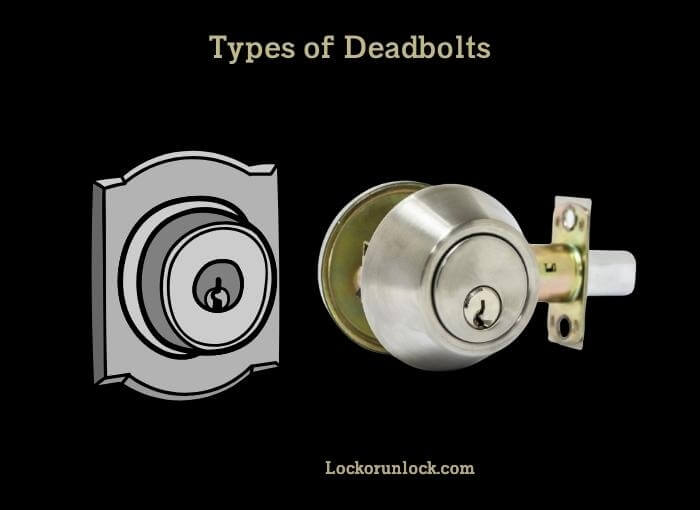Your home is your sanctuary, where you and your loved ones should feel safe and secure. Unfortunately, the reality is that homes are vulnerable to break-ins and burglaries. According to the FBI, there were over 1.2 million burglaries in the United States in 2019, resulting in an estimated $3.4 billion in property losses. Installing deadbolts is one of the most effective ways to improve home security and protect your family and belongings.

Deadbolts are a type of lock that provides a higher level of security than traditional locks. They are designed to resist forceful entry and can withstand a significant amount of pressure. A deadbolt operates by using a bolt that extends from the door into the door frame, making it much more difficult for an intruder to kick the door in or pry it open.
Types of Deadbolts
Deadbolts come in different types, each with its own advantages and disadvantages. Understanding the differences between the types of deadbolts can help you choose the one that’s right for your home.
Single Cylinder Deadbolts
Single-cylinder deadbolts are the most common type of deadbolt. They are operated by a key on the outside and a thumb turn on the inside. Single-cylinder deadbolts are easy to use, and they offer a high level of security. They are also affordable and widely available.
However, one disadvantage of single-cylinder deadbolts is that they can be vulnerable to break-ins if someone can gain access to the inside of your home, such as through a window. Once inside, they can easily turn their thumb turn and unlock the door.
Double Cylinder Deadbolts
Double-cylinder deadbolts require a key to unlock from both the inside and outside. This makes them more secure than single-cylinder deadbolts, as they can’t be unlocked by simply turning the thumb turn. They are a good choice for doors with windows or that are close to a window or glass panel.
The disadvantage of double-cylinder deadbolts is that they can be a safety hazard in case of emergency. If someone needs to quickly exit the home, they may not be able to find the key in time to unlock the door.

Smart Deadbolts
Smart deadbolts use technology to provide keyless entry and can be operated remotely using a smartphone app. They offer convenience and flexibility, as you can grant access to others remotely and keep track of who enters and exits your home.
Smart deadbolts also offer a high level of security, as they use encryption and two-factor authentication to prevent unauthorized access. Some models even come with features such as geofencing, which can automatically lock or unlock the door when you leave or enter a certain area.
The disadvantage of smart deadbolts is that they can be vulnerable to hacking and technical glitches. It’s important to choose a reputable brand and model and keep the software up to date to minimize the risk of a security breach.
Deadbolt Features
When choosing a deadbolt for your home, it’s important to consider its features. Here are some key features to look for:
Material
Deadbolts can be made from different materials, including brass, steel, and bronze. Choose a deadbolt that is made from a durable material that can withstand forceful entry attempts.
Bolt Size
The size of the deadbolt’s bolt determines how securely it can hold the door in place. Look for a deadbolt with a bolt that extends at least one inch into the door frame.
Grade
Deadbolts are graded based on their level of security, with Grade 1 being the highest level of security. Look for a deadbolt that is at least Grade 2, which provides a good level of security for most homes.
Backset
The backset is the distance between the edge of the door and the center of the lock. Choose a deadbolt with a backset that matches your door’s specifications to ensure a proper fit.
Strike Plate
The strike plate is the metal plate on the door frame that the deadbolt extends into. Look for a deadbolt with a reinforced strike plate that is securely fastened to the frame.
Keyway
The keyway is the slot on the deadbolt where the key is inserted. Choose a deadbolt with a high-quality keyway that is resistant to picking and bumping.
Installation
Choose a deadbolt that is easy to install and comes with clear instructions. If you’re not comfortable installing the deadbolt yourself, consider hiring a professional locksmith to do the job.
Deadbolt Installation
Installing a deadbolt on your door is an important step in enhancing the security of your home. Here are some steps to follow when installing a deadbolt:
Choose the right deadbolt
Choose a deadbolt that fits your door and provides the level of security you need. Make sure it has the features you want, such as a reinforced strike plate and a high-quality keyway.
Gather Your Tools
You’ll need a drill, drill bits, a screwdriver, a hammer, a chisel, and a measuring tape.
Mark the Location
Using a measuring tape, mark the location where you want to install the deadbolt. The deadbolt should be installed at least six inches above the door knob.
Drill the Hole
Using the appropriate size drill bit, drill a hole through the door at the location you marked.
Install the Bolt
Insert the deadbolt’s bolt into the hole and mark the location of the bolt’s strike plate on the door frame.
Chisel the Strike Plate
Using a chisel and hammer, chisel out the area on the door frame where the strike plate will be installed.
Install the Strike Plate
Using screws, install the strike plate on the door frame.
Install the Thumb Turn
Insert the deadbolt’s thumb turn into the hole on the inside of the door and secure it with screws.
Install the Exterior Plate
Attach the deadbolt’s exterior plate to the outside of the door using screws.
Test the Deadbolt
Test the deadbolt to make sure it’s functioning properly. Make sure the bolt extends fully into the strike plate and the thumb turn can lock and unlock the deadbolt.
Maintaining Deadbolts
Once you’ve installed a deadbolt on your door, it’s important to maintain it properly to ensure it continues to function properly and provide the security you need. Here are some tips for maintaining your deadbolt:
Lubricate the Lock
Use a silicone-based lubricant to lubricate the lock and keyway. Avoid using oil-based lubricants, which can attract dust and debris and cause the lock to become clogged.
Tighten Loose Screws
Check the screws on the deadbolt and strike plate regularly to make sure they are tight. Loose screws can cause the deadbolt to become misaligned and make it easier to break into your home.
Keep the Door Frame and Strike Plate Clean
Dirt and debris can accumulate on the door frame and strike plate, making it harder for the deadbolt to extend fully into the strike plate. Clean the door frame and strike plate regularly to ensure they are free of debris.
Replace Worn Parts
If the deadbolt or any of its parts become worn or damaged, replace them as soon as possible. A damaged deadbolt can be easier to break into and may not provide the level of security you need.
Test the Deadbolt Regularly
Test the deadbolt regularly to make sure it’s functioning properly. Make sure the bolt extends fully into the strike plate and the thumb turn can lock and unlock the deadbolt.
Consider Upgrading the Deadbolt
If your deadbolt is old or doesn’t provide the level of security you need, consider upgrading to a newer, more secure deadbolt. Look for a deadbolt that has features such as a reinforced strike plate and a high-quality keyway.
Choosing the Right Deadbolt for Your Home
Choosing the right deadbolt for your home is an important step in enhancing the security of your property. Here are some factors to consider when choosing a deadbolt:
Material
Deadbolts can be made from different materials, such as brass, steel, or bronze. Each material has its own advantages and disadvantages in terms of strength, durability, and price. Consider the material that fits your budget and security needs.
Keyway
The keyway is the shape of the keyhole on the deadbolt. A high-quality keyway can provide added security by making it more difficult for someone to pick or bump the lock. Look for a deadbolt with a keyway that is resistant to picking and bumping.
Grade
Deadbolts are graded based on their strength and durability. The American National Standards Institute (ANSI) grades deadbolts from Grade 1 (highest) to Grade 3 (lowest). Consider a Grade 1 or Grade 2 deadbolt for maximum security.
Size
Deadbolts come in different sizes to fit different door thicknesses. Make sure to choose a deadbolt that fits your door and is the appropriate size.
Features
Look for deadbolts with features such as a reinforced strike plate, which can help prevent the deadbolt from being kicked in, or a keyless entry system, which can provide added convenience and security.
Price
Deadbolts can vary in price depending on their material, grade, and features. Consider your budget when choosing a deadbolt, but keep in mind that investing in a higher-quality deadbolt can provide added security and peace of mind.
Professional installation
Consider hiring a professional locksmith to install your deadbolt. A professional can ensure that the deadbolt is installed properly and provide advice on the best deadbolt for your home’s specific needs.
Conclusion
Deadbolts are an essential component of home security. Choosing the right deadbolt and maintaining it properly can help protect your property and loved ones. By considering factors such as material, keyway, grade, size, features, and price, you can select a deadbolt that fits your home’s specific needs and budget.
Regular maintenance, such as lubricating the lock, tightening loose screws, and cleaning the strike plate, can help ensure that your deadbolt functions properly and provides the level of security you need. Don’t forget to test the deadbolt regularly and consider upgrading to a more secure deadbolt if necessary. With a high-quality deadbolt in place, you can have peace of mind knowing that your home is secure.
Read more:
